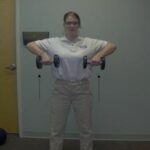There’s no way around it. Once you have a rotator cuff injury, you’re looking at months of healing. Never attempt to “work through” the pain. This will cause further damage. You can’t tough this one out. Painkillers are of no use because they will conceal the pain, and that pain is your warning that alerts you to what joint positions aggravate the problem! You need to know this!
An orthopedic doctor should examine your shoulder. He or she may prescribe anti-inflammatories, which may eliminate the pain. But unlike plain painkillers, an anti-inflammatory can promote healing.
There is an assortment of rehab exercises for the rotator cuff, and your doctor should set you up with a shoulder rehab specialist. Usually, rest alone isn’t sufficient to heal the problem. Because while the cuff is resting for a few months, it “forgets” how to be an efficient structure. So when you return to lifting a few months later, the cuff will be reinjured or more injured, and you’ll be back to square one. “Remember, it is critical for patients to participate in a home exercise program to properly rehabilitate their shoulder. If you only take medicine and go to physical therapy but neglect your home exercises, you will usually not get better,” Dr. Levine indicates.
Rehab exercises are absolutely mandatory, and can involve resistance tubing, light dumbbells or even just cans of soup as weights, plus very light resistance on machines. Stretching the chest and shoulder muscles is also key to recovery. So if you suspect a rotator cuff injury, see an orthopedic physician/rehab specialist for instruction in proper rehab routines.
Lastly, be patient. It may take six to 12 months before your shoulder returns to pre-injury condition.
Three incredible warm-up and conditioning exercises for your rotator cuff
1. Seated rows, supinated grip, pulley machine. Keep back straight, slightly arched, and vertical at all times. Place feet against equipment platform, legs slightly bent. Weight: 20-50 pounds, depending on your rowing strength. If you’re as strong as a bull, use 50 pounds. If you’re weak, use 20. Using an E-Z grip attachment, grab the E-Z portion of it with palms up, and begin rowing, pulling the bar all the way to your chest. Your hands should be just ahead of your ribs, upper arms past vertical. Your arms should essentially be in the position of elbowing someone behind you. Do not shrug or hunch shoulders. The entire shoulder girdle area should be stabilized and square. Hold the row position for two seconds, then release with a 2-count. Do 20 reps, three sets, 30 seconds in between. As you hold the row position and release, you will feel a stretch in the shoulder-pec area. You may even feel and hear some “popping.” This is normal and means that things are getting loosened up. Keep your back vertical and slightly arched at all times. Do not lean back as you row. Keep upper arms against your sides.
2. Lat pull-downs, very wide grip, in front of the neck. Weight range: 20-50 pounds; sets; 3; rest in between: 30 seconds. Tilt back between 10- 20 degrees. Keep back slightly arched. Keep forearms vertical at all times! Hold the pullover position for two seconds, keeping the bar about neck level. Upper arms should be vertical, chest slightly puffed out. Release with a 2-count. Raise to the point just before your arms become straight. Repeat 20 times.
3. Dumbbell presses, incline bench. Weight range: 5-20 pounds, depending on your strength; reps: 20; sets: 3; rest in between: 45-60 seconds. Incline bench angle: 30-45 degrees. Hand position: Palms facing each other at all times. Make sure you lower weights as far as possible, keeping upper arms to your sides.
Frequency of all routines: Twice a week for conditioning, and five times a week for rehab. However, two- to three-times weekly will produce results for rehab.

